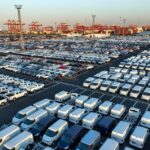The resilience of the Chinese economy
ELDA MOLINA DÍAZ AND EDUARDO REGALADO
The Chinese economy has shown a great capacity for resilience and development potential by more than meeting its growth objective of 5,2%, despite the complex challenges it has had to face internally and externally.
However, much of the analysis that appears in the Western media presents a gloomy view of the evolution and outlook of the Chinese economy. Some sources, based mainly on the results of recent years, highlight only the negative performance without analyzing it in a comparative manner with the rest of the world, or with the country's previous results, and based on this, they predict a pessimistic future. Others join in with fatalistic omens, more for their ill-intentioned interests in discrediting and containing the country, based on biased, partial and overvalued analyses.
China has had to face complex and profound internal and external challenges. Within the former, the real estate sector, which directly represents 11% of GDP (and indirectly around 25%), has contributed negatively to the country's overall economic growth since 2022. Its contribution to the increase in GDP has been reduced to approximately less 2% in 2023. Furthermore, in the midst of a situation of economic uncertainty, the population prefers to save and decline their purchases, which causes a restriction in domestic demand.
In the external order, in addition to the difficult context that the world economy is going through and what this implies, especially in commercial terms, the sanctions imposed by the United States in the commercial and technological sphere stand out in a very important way, due to fear of that country for China to become not only a source of manufacturing and imports for American consumers, but also a rival in all areas of its global hegemony. Likewise, other geopolitical tensions affect its surroundings and at a global level, which entail serious commercial and financial consequences.
Now, the Chinese economy shows strengths that have given it greater space than other countries to face the difficult situation and achieve its economic objectives. For example, China is not experiencing inflation, like the vast majority of countries on the international stage. Last year, its Consumer Price Index was 0,2%, while core inflation (excluding food and fuel) was 0,6%. Its producer price index fell 2,6%. Likewise, the country has a lot of room to cut interest rates and the cash reserve ratio, which no other economy can do.
Furthermore, China has a positive net worth balance, while those of the United States, Japan and Germany are negative. China's central government debt alone is around 21% of GDP. Estimates for local government debt obligations range only between 50% and 80% of GDP, including hidden liabilities. If we take the higher debt-to-GDP ratio of 110% for China's overall public debt, it still compares favorably with that of the United States federal government, which is about 140% of GDP, and with the central government debt of Japan of around 260% of GDP.
The financial assets owned by the Chinese government exceed its total financial liabilities. The net asset value – total assets minus total liabilities – of Chinese state-owned companies represents around 70% of GDP. Its foreign currency-denominated debt is insignificant as a percentage of GDP. Likewise, the average loan-to-value ratio for mortgages in major cities in China is around 40%, meaning house prices will have to fall by more than half to produce negative equity for homeowners. , which is not likely to happen.
In addition, the Chinese economy has a vast internal market, which has been progressively incorporated as the engine that drives the country's economy and protects it from the turbulence of the global environment, while at the same time, in a centralized manner, coherent policies and tools that have been stimulating the increase in domestic demand.
As a result, the Chinese economy has entered a phase of moderate growth after overcoming the hard times experienced after the impact of Covid-19. In 2023, growth stood at 5.2%, which, far from representing a slow pace, as some Western sources suggest, (although it is with respect to the rates presented in the past), is very high when compared to the from other countries, even developed ones.
China leads the world in the industries that enabled and were enabled by the Fourth Industrial Revolution: green energy, digitalization, industrial robots, artificial intelligence, etc. China has overtaken Japan as the largest car exporter this year, and a quarter of them are electric vehicles. In lithium batteries, an essential component of electric vehicles, mobile phones and other industries on this list, China went from zero percent of the global market in 2005 to 63% today. It has marked similar growth in wind energy and the installation of industrial robots.
It is noteworthy that the growth of new sectors linked to technological development has been compensating for the drop in the contribution of the real estate and other traditional sectors.
China has maintained its position as the second largest economy after the United States during those years until today. Likewise, according to the International Monetary Fund, China's participation in the world economy will be approximately 18,5% and will contribute about 35% to global economic growth in 2023.
Despite the effects on Chinese production and world trade due to the crisis triggered by Covid, China continues to be the leader in world trade. It is the largest exporter and the second largest importer of goods in the world. Its exports of goods have grown over the last 3 years despite the contraction of global trade and demand, as well as its share in global exports of goods, representing more than 15% of the total.
China is among the leading exporters and importers of services. Trade in services has grown in recent years despite the fact that some sectors have been greatly affected, as throughout the world, particularly travel. It is noteworthy that China has remained the main trading partner of 144 countries distributed in all regions of the world. It has displaced the United States in this concept in the European Union and in several Latin American countries. In 2022, exchanges with this region increased by 11%.
China is not free from internal and external economic challenges, but the country's economic fundamentals are solid, giving its government ample policy space to address its current economic slowdown, while its industrial development has positioned it well to the future. It will take a couple of years of stability and concrete political support for the private sector to fully regain confidence. Despite the detractors, it is foreseeable that the process of modernization and comprehensive development of a socialist country will deepen in the future.
Elda Molina Diaz She has a doctorate in Economic Sciences from the International Economics Research Center (CIEI) of the University of Havana.
Eduardo Regalado He is a researcher on Asia and Oceania, specialized in China, at the Center for International Policy Research (CIPI).










